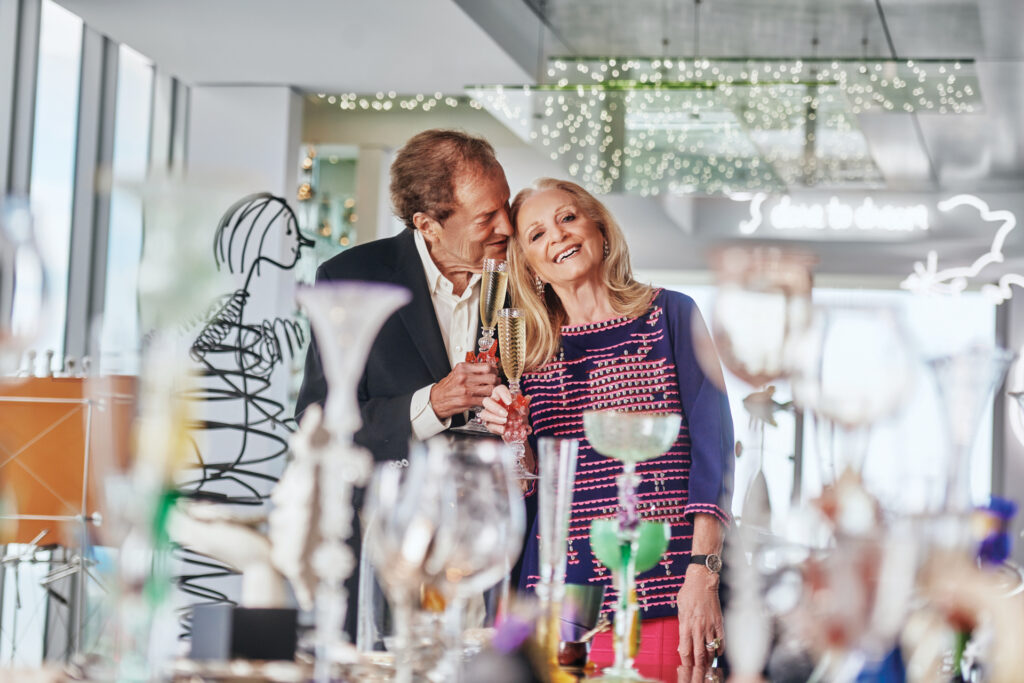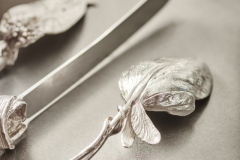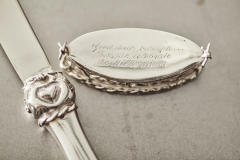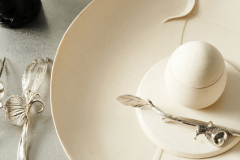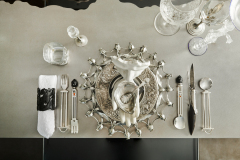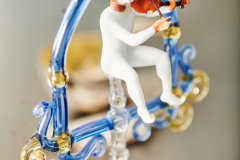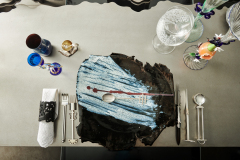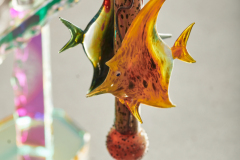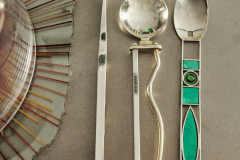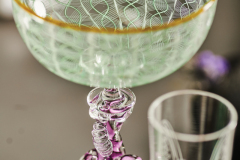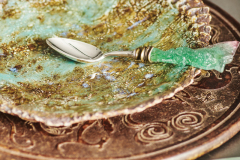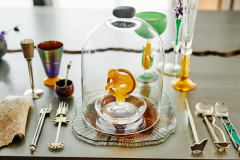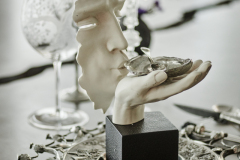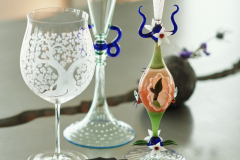“When I was 12 years old, I told my mother that I hated, hated, hated the holidays,” Suzanne Cohn says. By that time, she didn’t have a strong sense of belonging.
Her family, Holocaust survivors, who fled Europe following World War II, had been living in Australia for three years. Come Christmastime, Suzanne missed the masses that she’d been brought to by the Catholic family who hid them in Poland during Hitler’s reign, and at Hanukkah, she missed the Jewish customs her mother had given up, her faith shattered by the war.
Suzanne remembers her father gesturing toward the empty chairs encircling their dining room table. “He told me, ‘I can’t give you this,’” she says, referring to lost family members who should have filled the seats. “But my father promised me that, one day, I’d sit at a table with a big family of my own.”
Now, Suzanne and her husband, Norman, with the help of their house and art manager, Michael Smith, live out her father’s prophecy and make it into effervescent yet tactile experiences generously choreographed for family and friends. The Cohns collect what’s referred to as table art. (“Or maybe the art of the table,” Suzanne says. “That’s so much more elegant.”) In their homes, each plate, goblet, serving dish and spoon is a work of art.
The Cohns host feted dinner parties in their contemporary Naples penthouse that regularly puts their art to practical use. “I don’t want to live in a museum,” Norman insists. “If it breaks, it breaks. Think about people who spend a fortune on a very good opera ticket. What are they left with when they go home? The experience. All of it gets used.”
“The storytelling comes from each piece, not from the collection itself,” Suzanne adds, explaining that she doesn’t keep dining sets intact, but breaks them up to weave individualized settings. “Each setting is carefully orchestrated,” she says. She and Michael may pair Philadelphia artist Mardi Jo Cohen’s Art Deco-inspired flatware with port goblets that show stems made of swinging glassblown figures by Venetian Lucio Bubacco, their delicacy countered by a jagged-edged, inky black ceramic plate by New Jersey-based John Shedd. New Yorker Coral Dalton’s plate, with a small fish that appears as if it washed onto the porcelain, may lay next to a tiny salt cellar, reminiscent of a fossilized, speckled egg, by Australian Tracy Muirhead. The knives from the wedding silverware her father buried during the war and later recovered often make their way onto the table. Suzanne estimates that it may take two to three days to curate each setting, which is tailored to guests’ sensibilities.
The guest list itself is a considered labor of love. “It’s so critically important to both of us that we blend the guests,” Suzanne says. “They must share similar traits but be divergent.” The Cohns’ table stimulates conversation and nurtures relationships amongst people who might not otherwise break bread together. “It’s sharing,” Norman chimes in. “We just love to share with people and hope they leave with memories.”
During gatherings, the dinnerware perches directly on the buffed steel surface of the Cohns’ brawny dining room table, crafted by Canadian artist Colin Schleeh. The pieces pop against the table’s warm gray. Cleverly recessed lighting above—two rows of six minuscule spotlights, one for each seat when the table’s fully set for 12—makes the intricate table art cast dramatic shadows on the tabletop, like a web of lace.
The table art also blends seamlessly with the Cohns’ larger collection in their Mystique home, which mostly centers around glass art. Suzanne’s drawn to glass’ oxymoronic character. “It’s fragile but permanent in its hard surface. It’s a metaphor for life itself,” she says. Much of the artwork—like the infinity mirror installation of insects, birds, fish and reptiles endemic to Naples by Vienna-based Mischer’Traxler Studio, in the powder room—recalls the curiosity and playfulness of Alice in Wonderland.
Though the Cohns have too many pieces at this point for Suzanne and Norman to enumerate, Suzanne estimates that around 70 percent of their table pieces were directly commissioned from the artists, some of whom don’t usually foray into table art. Steve Tobin—whose large, abstracted White Rainbow Root sculpture graces the grounds of Naples Botanical Garden—was so inspired after a visit to the Cohns’ home that the Philadelphia-based sculptor fashioned a set of 14 dinner plates, imprinted with fabric and cast in porcelain to resemble shells, just for the couple.
Suzanne speaks about Tobin as she speaks about each artist from whom they’ve collected over the decades: warmly, as a dear and admired friend. “The simple purity of collecting something made in our lifetime means that we’re meeting and knowing the artist’s mind and heart,” Suzanne says. During a party the Cohns hosted in 2021 for all the artists whose work is represented in their Naples condo, Tobin hid birds’ nests made from shimmering wire around the apartment for Suzanne to later uncover one by one. The affection between the collectors and artists is enduring and mutual.
And the affection between Suzanne and Norman is still palpable and poetic after 58 years together. She recalls her 60th birthday, when Norman surprised her with a gift—flatware like the set François-Xavier and Claude Lalanne made for Salvador Dalí in 1965. During a visit to the Museum of Decorative Arts in Paris, Suzanne was riveted by the famed French sculpture and design duo’s work. “In one of the rooms was a whole table for 12 people set with this flatware. It had stanchions, so you couldn’t come close, but you could still see it and experience the magic,” she recalls, beaming. Unbeknown to Suzanne, Norman commissioned another set from Les Lalanne for her milestone birthday. The handles of each whimsical piece resemble twigs adorned with winged insects and curling, veined leaves, as if plucked from a forest floor and immortalized in silver. “Norman always likes to surprise me with things; he’s so romantic in his thinking,” she says, adding that Norman commissioned 120 pieces for the set. “There’s a Jewish saying for when you wish someone a long life, you wish them 120 years.”
Every piece on their table reflects the couple’s appreciation for life and those they hold dear. “Your values dictate what you do in your life,” Norman says. “And memories keep things alive,” Suzanne adds. Photos of their five children and 11 grandchildren are interspersed among the furnishings and artwork, showing that their penthouse—sleek and immaculate as it is—isn’t just a house but a home, a place for family to gather. And, when their loved ones share a meal around their thoughtfully arranged table, every chair is filled.

